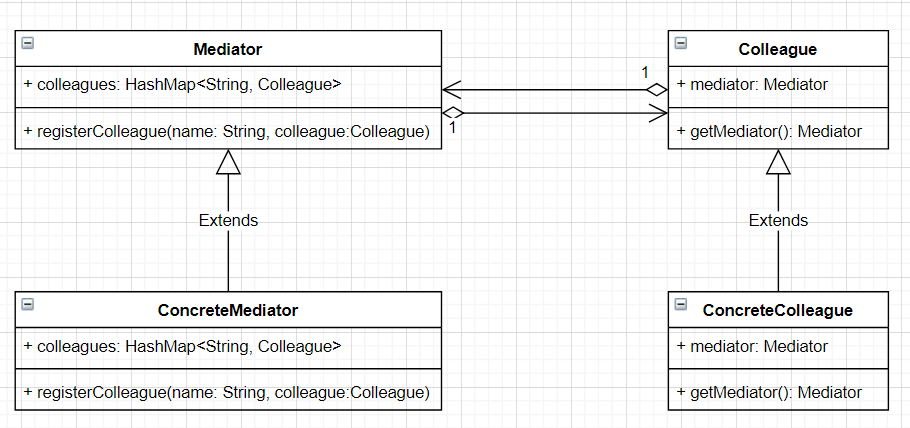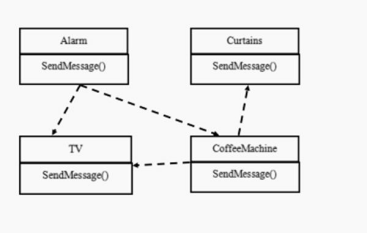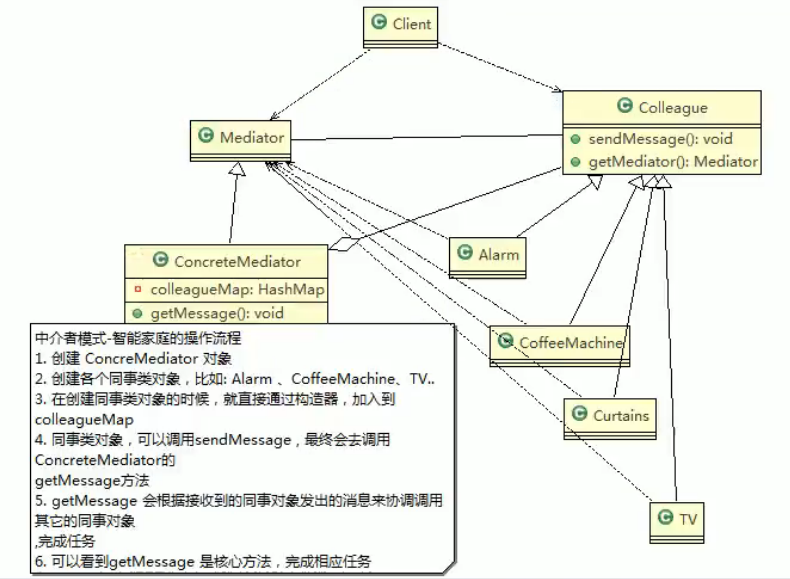中介者模式(Mediator Pattern)是用来降低多个对象和类之间的通信复杂性。这种模式提供了一个中介类,该类通常处理不同类之间的通信,并支持松耦合,使代码易于维护。中介者模式属于行为型模式。
基本介绍
意图:用一个中介对象来封装一系列的对象交互,中介者使各对象不需要显式地相互引用,从而使其耦合松散,而且可以独立地改变它们之间的交互。
主要解决:对象与对象之间存在大量的关联关系,这样势必会导致系统的结构变得很复杂,同时若一个对象发生改变,我们也需要跟踪与之相关联的对象,同时做出相应的处理。
何时使用:多个类相互耦合,形成了网状结构。
如何解决:将上述网状结构分离为星型结构。
关键代码:对象 Colleague 之间的通信封装到一个类中单独处理。
-
应用实例:
- 1、中国加入 WTO 之前是各个国家相互贸易,结构复杂,现在是各个国家通过 WTO 来互相贸易。
- 2、机场调度系统。
- 3、MVC 框架,其中C(控制器)就是 M(模型)和 V(视图)的中介者。
-
优点:
- 1、降低了类的复杂度,将一对多转化成了一对一。
- 2、各个类之间的解耦。
- 3、符合迪米特原则。
缺点:中介者会庞大,变得复杂难以维护。
-
使用场景:
- 1、系统中对象之间存在比较复杂的引用关系,导致它们之间的依赖关系结构混乱而且难以复用该对象。
- 2、想通过一个中间类来封装多个类中的行为,而又不想生成太多的子类。
注意事项:不应当在职责混乱的时候使用。
概括
基本介绍
- 中介者模式(Mediator Pattern),用一个中介对象来封装一系列的对象交互。中介者使各个对象不需要显式地相互引用,从而使其耦合松散,而且可以独立地改变它们之间的交互
- 中介者模式属于行为型模式,使代码易于维护
- 比如 MVC 模式,C(Controller 控制器)是 M(Model 模型)和 V(View 视图)的中介者,在前后端交互时起到了中间人的作用
中介者模式的原理类图

对原理类图的说明-即(中介者模式的角色及职责)
- Mediator:就是抽象中介者,定义了同事对象到中介者对象的接口
- Colleague:是抽象同事类
- ConcreteMediator:具体的中介者对象,实现抽象方法,他需要知道所有的具体的同事类,即以一个集合来管理 HashMap,并接受某个同事对象消息,完成相应的任务
- ConcreteColleague:具体的同事类,会有很多,每个同事只知道自己的行为, 而不了解其他同事类的行为(方法), 但 是他们都依赖中介者对象
我的理解
相当于房屋中介,只用将请求给他(如 租房、买房),他就可以调用相应的模块,将请求交给相应的模块去进行处理。
应用实例
智能家庭项目
智能家庭项目:
使用传统方式
类图:

传统的方式的问题分析
- 当各电器对象有多种状态改变时,相互之间的调用关系会比较复杂
- 各个电器对象彼此联系,你中有我,我中有你,不利于松耦合.
- 各个电器对象之间所传递的消息(参数),容易混乱
- 当系统增加一个新的电器对象时,或者执行流程改变时,代码的可维护性、扩展性都不理想 考虑中介者模式
使用中介者模式
- 应用实例要求
完成前面的智能家庭的项目,使用中介者模式 - 思路分析和图解(类图)

代码实现
Colleague
package com.nemo.mediator.smarthouse;
//同事抽象类
public abstract class Colleague {
private Mediator mediator;
public String name;
public Colleague(Mediator mediator,String name) {
this.mediator = mediator;
this.name = name;
}
public Mediator GetMediator() {
return this.mediator;
}
public abstract void SendMessage(int stateChange);
}Alarm
package com.nemo.mediator.smarthouse;
//具体的同事类
public class Alarm extends Colleague {
//构造器
public Alarm(Mediator mediator,String name) {
super(mediator,name);
//在创建 Alarm 同事对象时,将自己放入到 ConcreteMediator 对象中[集合]
mediator.Register(name,this);
}
public void SendAlarm(int stateChange) {
SendMessage(stateChange);
}
@Override
public void SendMessage(int stateChange) {
// 调 用 的 中 介 者 对 象 的 getMessage
this.GetMediator().GetMessage(stateChange,this.name);
}
}CoffeeMachine
package com.nemo.mediator.smarthouse;
public class CoffeeMachine extends Colleague {
public CoffeeMachine(Mediator mediator,String name) {
super(mediator,name);
mediator.Register(name,this);
}
@Override
public void SendMessage(int stateChange) {
this.GetMediator().GetMessage(stateChange,this.name);
}
public void StartCoffee() {
System.out.println("It's time to startcoffee!");
}
public void FinishCoffee() {
System.out.println("After 5 minutes!");
System.out.println("Coffee is ok!");
SendMessage(0);
}
}Curtains
package com.nemo.mediator.smarthouse;
public class Curtains extends Colleague {
public Curtains(Mediator mediator,this);
}
@Override
public void SendMessage(int stateChange) {
this.GetMediator().GetMessage(stateChange,this.name);
}
public void UpCurtains() {
System.out.println("I am holding Up Curtains!");
}
}package com.nemo.mediator.smarthouse;
public class TV extends Colleague {
public TV(Mediator mediator,this.name);
}
public void StartTv() {
System.out.println("It's time to StartTv!");
}
public void StopTv() {
System.out.println("StopTv!");
}
}Mediator
package com.nemo.mediator.smarthouse;
public abstract class Mediator {
//将给中介者对象,加入到集合中
public abstract void Register(String colleagueName,Colleague colleague);
//接收消息,具体的同事对象发出
public abstract void GetMessage(int stateChange,String colleagueName);
public abstract void SendMessage();
}ConcreteMediator
package com.nemo.mediator.smarthouse;
import java.util.HashMap;
//具体的中介者类
public class ConcreteMediator extends Mediator {
//集合,放入所有的同事对象
private HashMap<String,Colleague> colleagueMap;
private HashMap<String,String> interMap;
public ConcreteMediator() {
colleagueMap = new HashMap<String,Colleague>();
interMap = new HashMap<String,String>();
}
@Override
public void Register(String colleagueName,Colleague colleague) {
colleagueMap.put(colleagueName,colleague);
if (colleague instanceof Alarm) {
interMap.put("Alarm",colleagueName);
} else if (colleague instanceof CoffeeMachine) {
interMap.put("CoffeeMachine",colleagueName);
} else if (colleague instanceof TV) {
interMap.put("TV",colleagueName);
} else if (colleague instanceof Curtains) {
interMap.put("Curtains",colleagueName);
}
}
//具体中介者的核心方法
//1. 根据得到消息,完成对应任务
//2. 中介者在这个方法,协调各个具体的同事对象,完成任务
@Override
public void GetMessage(int stateChange,String colleagueName) {
//处理闹钟发出的消息
if (colleagueMap.get(colleagueName) instanceof Alarm) {
if (stateChange == 0) {
((CoffeeMachine) (colleagueMap.get(interMap.get("CoffeeMachine")))).StartCoffee();
((TV) (colleagueMap.get(interMap.get("TV")))).StartTv();
} else if (stateChange == 1) {
((TV) (colleagueMap.get(interMap.get("TV")))).StopTv();
}
} else if (colleagueMap.get(colleagueName) instanceof CoffeeMachine) {
((Curtains) (colleagueMap.get(interMap.get("Curtains")))).UpCurtains();
} else if (colleagueMap.get(colleagueName) instanceof TV) {//如果 TV 发现消息
//....
} else if (colleagueMap.get(colleagueName) instanceof Curtains) {
//如果是以窗帘发出的消息,这里处理...
}
}
@Override
public void SendMessage() {}
}ClientTest
package com.nemo.mediator.smarthouse;
public class ClientTest {
public static void main(String[] args) {
//创建一个中介者对象
Mediator mediator = new ConcreteMediator();
//创建 Alarm 并且加入到 ConcreteMediator 对象的 HashMap
Alarm alarm = new Alarm(mediator,"alarm");
//创建了 CoffeeMachine 对象,并 且加入到 ConcreteMediator 对象的 HashMap
CoffeeMachine coffeeMachine = new CoffeeMachine(mediator,"coffeeMachine");
//创建 Curtains,并且加入到 ConcreteMediator 对象的 HashMap
Curtains curtains = new Curtains(mediator,"curtains");
TV tV = new TV(mediator,"TV");
//让闹钟发出消息
alarm.SendAlarm(0);
coffeeMachine.FinishCoffee();
alarm.SendAlarm(1);
}
}中介者模式的注意事项和细节
- 多个类相互耦合,会形成网状结构,使用中介者模式将网状结构分离为星型结构,进行解耦
- 减少类间依赖,降低了耦合,符合迪米特原则
- 中介者承担了较多的责任,一旦中介者出现了问题,整个系统就会受到影响
- 如果设计不当,中介者对象本身变得过于复杂,这点在实际使用时,要特别注意

